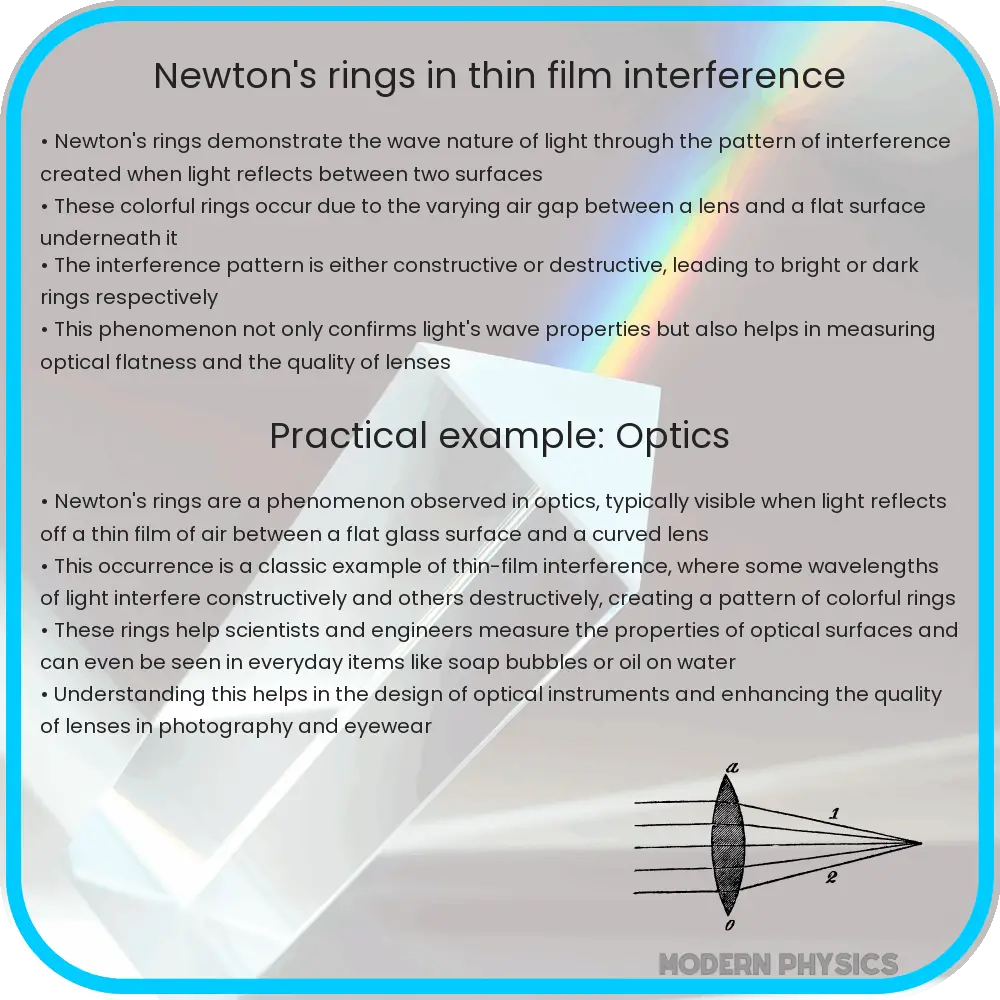Explore the fascinating world of Newton’s Rings, a key experiment in optics illustrating wave interference, thin-film analysis, and light properties.

Understanding Newton’s Rings: An Exploration of Optical Phenomena
Newton’s Rings are a captivating optical phenomenon that arise from the interference patterns of light waves. First observed by Sir Isaac Newton in the 17th century, these concentric rings of light and dark are not just visually striking but also serve as a fundamental experiment in the study of wave interference, thin-film analysis, and the properties of light. This phenomenon is most commonly observed when a plano-convex lens is placed on top of a flat glass surface, creating a thin air film between the two surfaces.
Principles Behind Newton’s Rings
At the heart of Newton’s Rings is the principle of wave interference. When a beam of monochromatic light (light of a single wavelength) is directed onto the lens setup, it reflects off both the bottom surface of the lens and the top surface of the glass. These reflected waves superimpose on one another, leading to interference patterns. Depending on the path difference between the two waves, they can undergo constructive interference (where the waves amplify each other) or destructive interference (where the waves cancel each other out), creating the alternating bright and dark rings observed.
Thin-Film Analysis through Newton’s Rings
Newton’s Rings provide a practical method for analyzing the properties of thin films. The variation in the diameter of the rings corresponds to changes in the thickness of the air film between the lens and the glass surface. By examining these patterns, scientists and engineers can derive precise measurements of film thickness, refractive indices, and other optical properties. This analysis is crucial in fields ranging from material science to optical engineering, where understanding the behavior of light at interfaces is essential.
Wave Interference and Optical Path Difference
The phenomenon of Newton’s Rings is a classic demonstration of wave interference, specifically illustrating how optical path differences affect the interference pattern. The path difference arises due to the slight curvature of the lens creating a varying air gap thickness. This difference in path length between the reflected light waves leads to the formation of the interference pattern. The conditions for constructive and destructive interference depend on whether the path difference is an integral multiple of the light’s wavelength or a half-integral multiple, respectively.
Applications and Implications of Newton’s Rings
The study and application of Newton’s Rings extend beyond academic curiosity, impacting various technological and scientific fields. For instance, the principles behind this phenomenon are utilized in the calibration of optical instruments, the testing of lens curvatures, and the measurement of very small displacements in engineering. Moreover, the methodology provides a non-destructive means of testing and is pivotal in the quality assurance processes for optical components. Additionally, in the realm of material science, the analysis of thin films using the interference patterns observed in Newton’s Rings offers insights into the properties of materials at the microscopic level, aiding in the development of coatings, sensors, and electronic devices.
Quantitative Analysis and Formulae
The quantitative analysis of Newton’s Rings allows for the precise measurement of physical quantities. The diameter of the nth bright ring, for example, is given by the formula \(D_n = 2\sqrt{rn\lambda}\), where \(D_n\) is the diameter of the nth ring, \(r\) is the radius of curvature of the lens, \(n\) is the ring number, and \(\lambda\) is the wavelength of the light used. This formula illustrates the direct relationship between the diameter of the rings and the properties of the light and lens, providing a foundation for precise optical measurements and experiments.
Challenges and Limitations
While Newton’s Rings offer a versatile tool for the analysis of optical phenomena, there are inherent challenges and limitations. Precision in experimental setup is crucial, as minor deviations can significantly affect the outcome and accuracy of measurements. Furthermore, the analysis assumes monochromatic light and ideal conditions that may not always be replicable in practical applications. Despite these limitations, the study of Newton’s Rings continues to be a valuable educational tool and a basis for research in optical physics.
Conclusion
Newton’s Rings encapsulate the fascinating interplay of light, matter, and mathematics. This phenomenon not only underscores the principles of wave interference and thin-film analysis but also finds practical applications in various scientific and engineering domains. As we delve into the microscopic and quantum realms, the insights gained from Newton’s Rings pave the way for innovations in optical instrumentation, material science, and beyond. Despite its historical roots, the study of Newton’s Rings remains at the forefront of optical research, exemplifying the enduring quest for understanding the fundamental properties of light and its interactions with the world around us.
